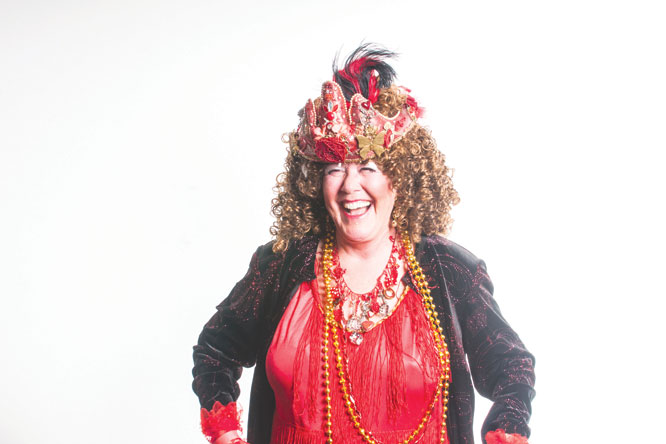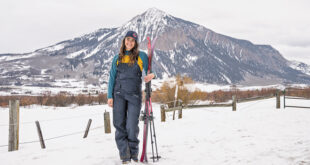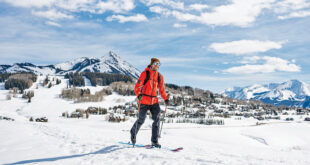Coloring her life, dreaming in Red
by Dawne Belloise
Suzanne “Soupy” Pierson was born in the midst of a raging Oklahoma tornado in a two-bed hospital above the town saloon and as she came wailing into this world, the delivering doctor’s father was exiting this life in the only other bed. So, it’s no wonder that she has a rebellious gusto for life and a fiery smile. She attributes her unruly mop to her birth circumstances. “It’s why I have curly hair,” she chuckles. “I was born in a big wind.” She is the perfect material to make up the Red Lady. Last week she was crowned number 39 in the long line of the famed sisters, the one whose reign could quite possibly see the victorious end for the fight for a mine-free Mt. Emmons.

Suzanne was raised in Tulsa through her preteens, and art and music were prevalent throughout her life. “My father was a magnificent baritone with a beautiful voice. He sang in the Methodist church. My mother could harmonize with her wonderful voice and perfect pitch and she played piano. There was always music in the house.” It rained a lot, she recalls, and although she was understandably frightened of storms, afterward her mom would take her and her brother driving on dirt roads to look for rained-out tortoises, which they would bring home as pets. “We had a little tortoise farm and we’d paint flowers and pretty stuff on their shells. I was only three or four years old, still in my little ruffled panties.”
Suzanne wound up in Denver as she hit her young teen years when her parents divorced and her mother moved the kids back to her own native Mile High City. Suzanne joined a softball team, “Pepe’s Pizza,” she smiles. “I could bat, I could hit ‘em,” she touted proudly. “I was sledding and ice skating. We couldn’t afford to ski.” But she started skiing in high school when she was able to take the school bus trips on weekends. “I learned to ski on long wooden skis with leather boots,” she reminisces.
She graduated from Wheatridge High School in 1964 and says the only way she could afford to go to college was on scholarships, grants and student loans, which she got. Off she went to Colorado State University (CSU) in Fort Collins, enrolling as a humanities major, later switching to art. “I loved art so much in high school and I took all the art classes that were offered but I had to choose art over music because they wouldn’t let me do both. So, I did music on the side. I sang and played for pleasure.”
She sang in church choirs and talent shows all the time, and as a sophomore in high school her church group took a trip to Colorado Springs that would alter her perception of music when a friend brought a ukulele along. “I was so fascinated with that instrument. She taught me a couple of chords and I came home so excited and told my mom, I gotta have a guitar. My aunt happened to have an old steel-string Stella in the basement. I got a book and taught myself.”
With musical influences like Judy Collins, Peter, Paul and Mary, Buffy Saint Marie, Dylan, Baez, and Richard and Mimi Farina, she became a folk singer herself. “I played everywhere I could, high school, campfires, church youth gatherings. Eventually people started asking me to play and I did, unfettered!” She was talented to the point that when a sorority leader suggested she perform for a living, Suzanne picked up her guitar and stomped right over to the new Pizza Hut in Fort Collins to ask for a job.
“I asked if I could sing and they said sure, so I sang traditional folk songs and my originals on Saturday nights for tips, pizza and one beer, which was 3.2 Coors. That was the beginning of my gigs. I was a girl and a guitar, a singer-songwriter for three decades.” It helped Suzanne earn her way through college and she received a performance scholarship through the music school, even though she never took any music courses while she was enrolled there.
In 1966, Suzanne met a woman recruiter for World Campus Afloat, a fully accredited liberal arts college sailing around the world on a cruise ship. The recruiter offered her a scholarship on the S.S. Ryndam, and the following semester Suzanne boarded the ship and went around the world. Because of her enthusiasm and talent, the college offered her a student assistant position for an additional semester, and she traveled around the world again to ports in South America, South Africa, India, Malaysia, and Hong Kong before she went back to CSU to graduate in 1970.
“After college I went to Santa Ana, Calif., to make music and paint, when the World Campus Afloat called again asking me to be on staff as a resident assistant, helping organize kids for all of the field trips, pre-port trips, presentations and briefings. I was like their older sister, the grad student. That was 1971.”
While she was cruising, she had a rendezvous with an old childhood friend and spent five days off-ship with him in Japan—and they fell in love. When she left port and sailed on to India, there was a letter waiting there with his marriage proposal, to which she telegrammed back her acceptance. “I had no idea what it would mean. I was really naïve. I was only 23,” she later realized. “I sailed on, with everyone’s giggly approval about having a fiancé. We were trying to get to Durban, South Africa, our next port, and we hit the edge of a typhoon in the Indian Ocean.
“There were 40-foot waves over the bridge of this ocean liner that held about a thousand people. They battened down everything and we were just hanging on. The cargo in the belly of the boat was tied down with straps that snapped and all the cargo shifted to one side of the boat and we were listing at 11 degrees. We listed into Durban, 11 degrees off keel and we were really happy to see land,” she said thankfully. As the tug boat pulled the ship into harbor, the purser’s office called to tell her that John, her now fiancé, had gotten transferred to South Africa from the refineries in Japan as a chemical engineer and was on the pilot boat coming out to meet her ship. “I was on the bow of my ship and he was on the bow of the pilot boat coming to meet my ship and I had 399 students behind me screaming.” Suzanne notes that this was well before the famous DiCaprio-Winslow Titanic scene.
John and Suzanne got married that night, and they both played guitar at their wedding with the ship’s crew dancing out of the kitchen with trays and trays of peanut butter sandwiches since they hadn’t had time to stock food after the typhoon. She and John went off on their honeymoon just south of Johannesburg and afterward, she flew back to Cape Town to rejoin her crew, but in the meantime, she was already having second thoughts about being a wife. “I am too independent.”
She returned to the states for five months, connecting with Buddy Kaye, a well-known publisher at the time who put her into clubs like the Troubadour in Hollywood. “He marched me up and down Sunset Strip, taking me into all the major record companies. Carole King was just hitting the market as the first woman who was a real singer-songwriter headliner, not just a girl in the band, and recording companies wanted to look for more women of that caliber. They offered me a job as a songwriter doing what Carole used to do, but only offered me $50 a week to write music, folk songs. I couldn’t live on that in Hollywood and LA is not a pretty place — it’s a crazy, false superficial world. So I turned them down.” She felt she should at least give wifedom a try in South Africa, so she went, with her publisher’s blessing.
Back in South Africa, she hooked up with immigrants, many of them from the British Isles, all of them making music as part of the underground Freedom Folk Music movement, even though anything that even hinted about freedom was banned in South Africa. She was discovered by the number one record producer in Africa, who gave her a contract to record an LP of her originals. “I got my break at the Natal Folk Music Festival in Durban, and afterwards I became very big in South Africa.
“They didn’t have TV and nobody had phones, you had to go to a big city to make a call,” Suzanne says. She recalls that to them, she was the real thing, what they had seen in their glossy magazines from Europe and America. “I was the big-haired gal that could sing. And sing I did—every opportunity I could get I would travel away from John and that little suburb of bigotry, hatred and apartheid to go perform.” After a radio interview with a widely known DJ, she was recognized as a major American folk singer talent. “I played with wonderful musicians. The record I made was the first record by an American musician made in South Africa specifically for an international market.”
Although her husband supported her music, Suzanne recognized that things had changed and the traditional roles of marriage suddenly loomed grimly. “I lived with him in Africa for two years until I couldn’t handle it any longer. I couldn’t see my future being his wife. And there was apartheid, which sickened me.” When her husband showed an ugly side of bigotry and racism, and the rules for Africans were so appalling to her and so against her foundational beliefs that she could no longer live watching the oppression, a friend emerged who was traveling back through Europe and she determined it was time to leave.
It was 1974 and the two hitchhiked out of there, taking three dangerous months to get to London and then back to the States, where she started her life as a divorced free woman, continuing her music career.
“I worked with an African-American poet dramatist from New York. I was the guitarist-songwriter and we performed women’s movement and environmental music. We were right on the cusp of the Earth Day consciousness and I had a lot to say as a folk musician and she as a poet, so we toured the country. I went back to school at CU-Denver and got my master’s in humanities, and began my teaching career at age 40. I taught mostly elementary education music for 15 years in public schools, also middle and high school and finished my career as an adjunct college professor at CU and Metro State.” Suzanne smiles, knowing she followed the path she chose.
In 1990, she met the love of her life, Monica Ariowitsch. “Monica is my champion. I quit elementary school teaching when a check-up revealed ovarian cancer. I was 55 and I went through both the medical process and alternate healing medicine. I caught it early. It changed my life. Monica saw me through all that. I’m 15 years in remission now.” When all was said, done and healed, Suzanne went back to teaching university classes until 2008, “then Monica and I started traveling quite a bit, all over the world. I’ve probably set foot in 100 countries and there are still many more to go!” The two have been together, supportive companions and in love, for 26 years, living in Crested Butte since 2012.
“I first came to Crested Butte in 1979 because I was an actor in Cleo Parker Robinson’s repertory theatre company, which brought us here on a grant that year,” she says of her first trip to Crested Butte. “I loved it. I started coming up to ski and I came back in 1990 with a children’s musical I had written that gained international acclaim, Bodhi and the Rainforest. It won the United Nations Environment Program Earth Prize. The play was picked up by the Smithsonian Institute and we performed it for thousands of kids with child actors. It won all sorts of awards and I was acknowledged by Governor Romer in Denver with the Governor’s Prize for Excellence in Education.” After she and Monica bought their home in Skyland, Suzanne laughs that it was, “A no brainer to retire in Crested Butte, and we moved into our home and started fishing out the backyard on the Slate.”
Between all her own creative endeavors in music and art, Suzanne teaches watercolor painting and is in the process of developing a new KBUT program called Sounds Like Art, a five minute radio show series. She’s also on the board of the Crested Butte Center for the Arts and involved with the newly developing Creative District when she’s not doing guest services on the mountain, or performing her new role as Red Lady#39. “I will be doing more music, and I’ve done a few open mics. I’ve got songs and paintings in my head and time on my hands. I’ve been coming up to Crested Butte since the ‘70s and I’m turning 70 on April 11,” and she practically squeals at the delight of not only having reached that landmark as a septuagenarian but excitedly adds, “AND I get a discounted ski pass for next season!” She confirms that she’ll stay in Crested Butte, since “until we get too decrepit, we’re living here.”
 The Crested Butte News Serving the Gunnison Valley since 1999
The Crested Butte News Serving the Gunnison Valley since 1999




